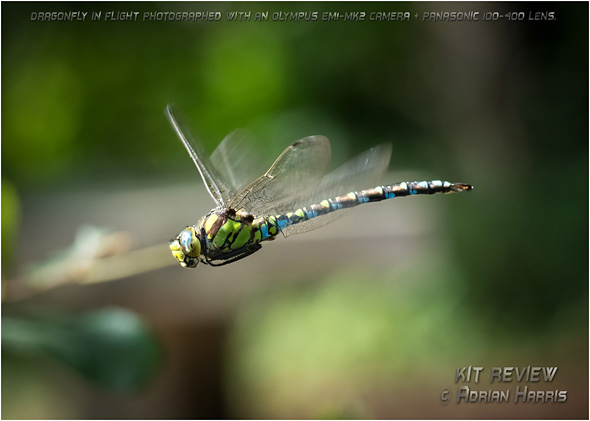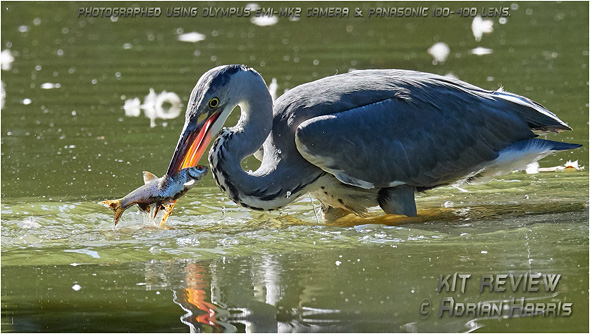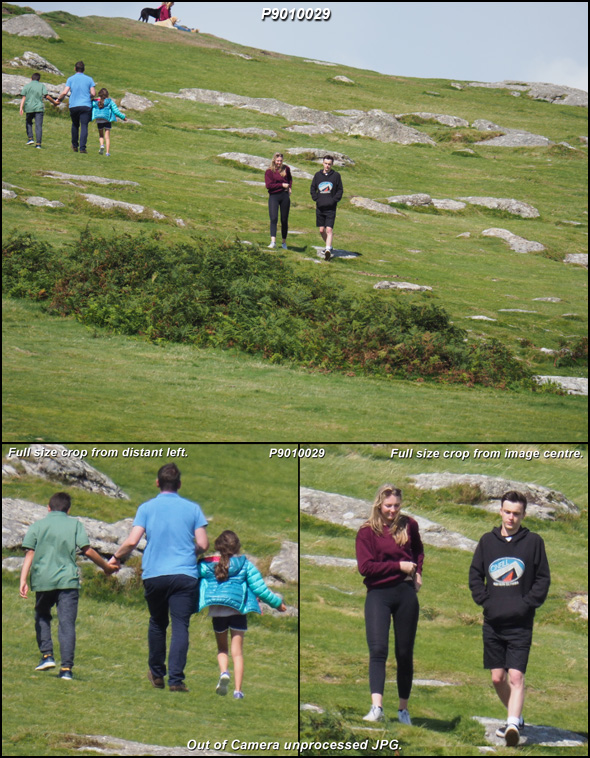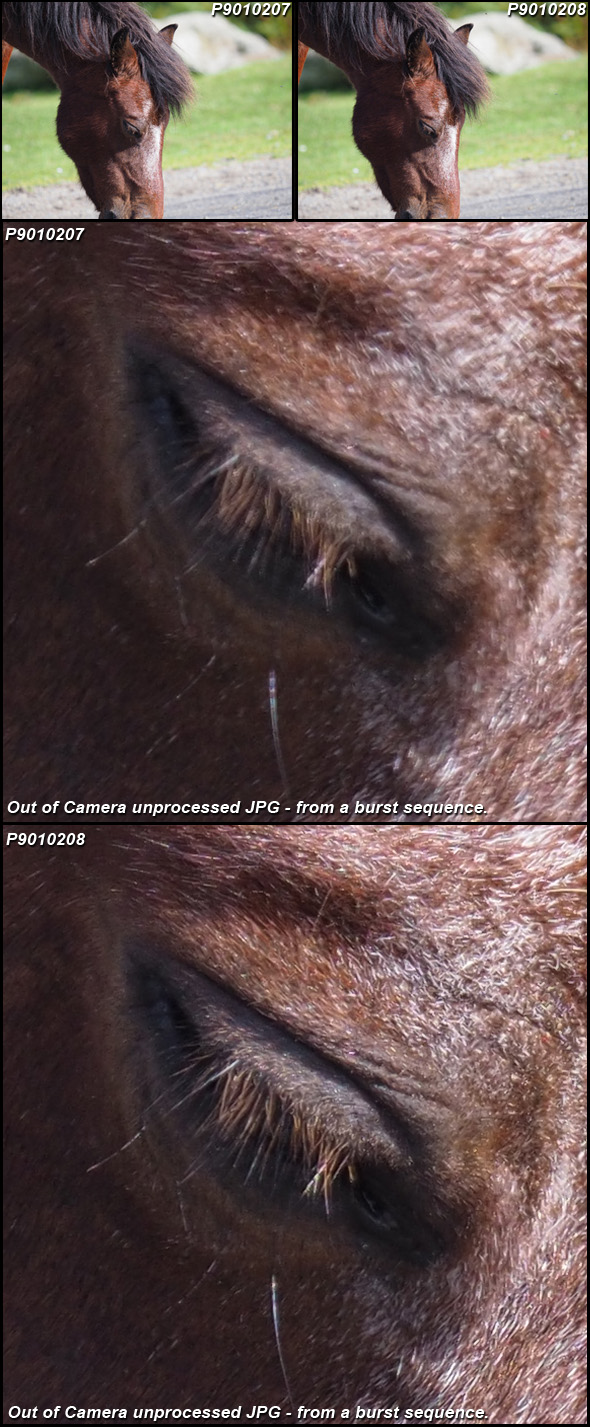 |
ARTICLE MENU
|
M4/3 System
(8th September 2017)
3 Weeks in with an
Olympus EM1-Mk2...
The GOOD - and the seriously BAD !!!
As a long time fan of Mirrorless cameras and
the M43 system since Panasonic launched its original G1 back in 2009, I
have been thrilled with the systems rapid progress and the direction of
development as regards exceedingly capable lenses and camera sensors
which now on flagship models exceed that of many large DSLR’s from only
a couple of years previous.
For the last year I have been shooting with Panasonics fabulous GX8
which quite frankly performance wise has blown me away. I am totally
confident when using it in any professional situation and have no
concerns as it will always deliver the goods.
So why have I just bought an Olympus?
However for the odd free-time scenario when I am out playing there were
a couple of features on Olympus’s latest OMD flagship the EM1-Mk2 that I
was keen to try to see if they really could make my life shooting very
difficult subjects a little easier. And hence decided to throw caution
to the wind and blew some of the kids inheritance to test how well the
new features
would work.
Subjects in flight - no problem...
Photo - Dragonfly in
Flight
(Processed in RAW to taste)
Camera: Olympus EM1-Mk2 @ 1/1000sec, ISO1600, S-AF, IBIS on.
Lens: Panasonic 100-400 @ 250mm, F5.6.
What it does well -
the EM1-Mk2 using S-AF focus locked on instantly to the nearest
subject even though there was a very busy background allowing -
grab shots like this passing dragonfly in flight.
Click the dragonfly image to see a larger photo.
|
 |
Photo - Dragonfly in
Flight
(Processed in RAW to taste)
Camera: Olympus EM1-Mk2 @ 1/1000sec, ISO1600, S-AF, IBIS on.
Lens: Panasonic 100-400 @ 250mm, F5.6.
What it does well -
the EM1-Mk2 using S-AF focus locked on instantly to the nearest
subject even though there was a very busy background allowing -
grab shots like this passing dragonfly in flight.
Click the dragonfly image to see a larger photo.
|
Strongly Backlight Subjects - no problem...
Photos - Heron
Eating Fish
(Processed in RAW to taste)
Camera: Olympus EM1-Mk2 @ 1/1000sec, ISO1600, S-AF, IBIS on.
Lens: Panasonic 100-400 @ 250mm, F5.6.
(Processed in RAW to taste)
What it
does well - the EM1-Mk2 using S-AF focus locked on to the heron
instantly despite the strong backlight which in the past would
fool many auto-focus systems.
Click the Heron image to see a larger photo.
|
 |
Photos - Heron
Eating Fish
(Processed in RAW to taste)
Camera: Olympus EM1-Mk2 @ 1/1000sec, ISO1600, S-AF, IBIS on.
Lens: Panasonic 100-400 @ 250mm, F5.6.
(Processed in RAW to taste)
What it
does well - the EM1-Mk2 using S-AF focus locked on to the heron
instantly despite the strong backlight which in the past would
fool many auto-focus systems.
Click the Heron image to see a larger photo.
|
Happiness and Woe’s…
First off the Good:
- Have I managed to get some amazing
shots with it that I would have had great difficulty to do with my
other cameras – YES.
Next the Bad:
- Would I trust it to use on a serious
once only chance shot – NO*.
* Please note that after a firmware update
the Em1-Mk2 focus drift
situation has
now changed dramatically, to the point at which I think the Olympus
Em1-Mk2 is now the camera of my dreams and I would trust it to get
the shot where others may well fail.
Okay so what’s the rub… ...Focus
Drift !
Well ignoring the complex menu and poorly written full e-manual – whose
explanation of the control which changes ‘3 fish’ to ‘1 fish’ is just a
bigger picture of ‘3 fish’ and ‘1 fish’ (I don’t even photograph fish!)
– the camera itself is certainly a powerful beast, albeit one that is
initially very time consuming to setup for specific tasks.
‘IF’ setup correctly the EM1-Mk2’s general performance is
startling but be warned of its speed. At first I had set the burst rate
a little high on (totally) silent shutter and as soon as I nudged the
shutter button for the briefest moment I had managed to capture about a
zillion full resolution shots of my shoe in both jpg and raw, …which
certainly brings a whole new context to the phrase ‘snappy performance’!
I mainly wanted the camera for features applicable to nature
photography, where I felt the ‘phase detect + contrast detect’
auto-focus, the ability to set the auto-focus range within specified
maximum and minimum limits, and the ultra high speed burst rate, could
all add up to bring something special to the game.
The EM1-Mk2 does indeed find focus fast, very fast, even on incredibly
difficult subjects such as a fast moving dragonfly against a busy
background, where I have successfully managed to nail full frame bursts
with ease using only the basic single shot auto focus S-AF setting
(which is non tracking). Yet despite this there is something very
strange going on when trying to photograph even the simplest of subjects
which seams rather unexplainable… And this is where the EM1-Mk2 fails
big time…
Photos - Heron
burst sequence illustrating focus drift
(OOC jpg's)
Camera: Olympus EM1-Mk2 @ 1/800-1/1000sec, ISO1600, S-AF,
IBIS on.
Lens: Panasonic 100-400 @ 250mm, F5.6.
The heron photos
below have been selected from a sequence of short bursts to best
illustrate
the typical misbehaviour of the Olympus EM1-Mk2 focus system.
All these were taken with
the camera set identically to focus on the centre of the image
using a small focus area, yet
despite this the camera appears to choose to focus randomly
around the image.
(The thumbnail images show the entire photo from which the
larger images are crops.
I have indicated on each where I think the camera appears to be
focusing.
The camera was using silent shutter and the settings remained
constant.)
Click any heron image below to see a larger photo.
|
 |
Photos - Heron
burst sequence illustrating focus drift
(OOC jpg's)
Camera: Olympus EM1-Mk2 @ 1/800-1/1000sec, ISO1600, S-AF,
IBIS on.
Lens: Panasonic 100-400 @ 250mm, F5.6.
The heron photos
above have been selected from a sequence of short bursts to best
illustrate
the typical misbehaviour of the Olympus EM1-Mk2 focus system.
All these were taken with
the camera set identically to focus on the centre of the image
using a small focus area, yet
despite this the camera appears to choose to focus randomly
around the image.
(The thumbnail images show the entire photo from which the
larger images are crops.
I have indicated on each where I think the camera appears to be
focusing.
The camera was using silent shutter and the settings remained
constant.)
Click any heron image above to see a larger photo.
|
I first noticed the focus-drift
when photographing a heron catching a fish
When taking a series of short bursts using a
small central focus grouping the camera captured the fast action with
ease, yet as soon as the heron slowly turned, the focus jumped all over
the place – even towards the outside of the frame - and at one point
took a totally out of focus shot despite the fact I had set it the
camera to achieve focus as a priority over shutter release priority!
Now at first I thought this was possibly issues arising due to using a
very long lens and me possibly wobbling, but since then I have taken the camera
out on a simple task where the focus failed miserably at a critical
decisive moment (unforgiveable), and have since run a series of small checks on focus and also
consistency of sharpness:
Focus drift to nowhere!!!
This should have been an easy task, a very
slow moving steam train with no panning involved. Learning from past
experience I did not set the EM1-Mk2 on single point focus because when
that focus point hits a plain featureless surface - which is very
possible with parts of the locomotive - it will not be able to gauge how
to focus. Hence a 5 point central grouping was chosen to ensure that it
would always have a feature to lock onto within that range. However as
can be seen below the camera decided otherwise:
Photos - The Flying
Scotsman
(OOC jpg's)
Camera: Olympus EM1-Mk2 @ 1/800sec, ISO400, S-AF, IBIS on.
Lens: Panasonic 14-140 Mk2 @ 14mm, F6.3.
Using the small 5
point central focus grouping on the EM1-Mk2 and fitted with the
Panasonic 14-140 Mk2 lens on its widest angle setting, the
camera locked onto the locomotive immediately. And I
took a series of very low speed bursts during which the camera
constantly drifted in and out of focus.
(The
images below illustrate the seriousness of the problem
encountered. None of the blurred images have a
sharp point of focus,
yet the camera was set to not fire unless the image was focused
correctly I was not sure how long the locomotive would appear
when it arrived, but I was hoping to capture it between the
speed sign and the building. It just fitted, however that was
the shot with the worst blur as you will see from the
second to last image!)
Click on any photo below to see a larger image.
|
 |
Photos - The Flying
Scotsman
(OOC jpg's)
Camera: Olympus EM1-Mk2 @ 1/800sec, ISO400, S-AF, IBIS on.
Lens: Panasonic 14-140 Mk2 @ 14mm, F6.3.
Using the small 5
point central focus grouping on the EM1-Mk2 and fitted with the
Panasonic 14-140 Mk2 lens on its widest angle setting, the
camera locked onto the locomotive immediately. And I
took a series of low speed bursts during which the camera
constantly drifted in and out of focus.
(The
images above are a selection to illustrate the problem
encountered. The thumbnails show
the entire image, and below that are full size 'Out Of Camera'
JPG crops from the centre
where I focused the camera. None of the blurred images have a
sharp point of focus,
yet the camera was set to not fire unless the image was focused
correctly.)
Click any train image above to see a larger photo.
|
Focus wandering away from the image
centre:
The following image of people walking on
Dartmoor is not the best example I could have chosen to illustrate the
problem. But not realising at the time that I would be writing a
critique in the future I went and deleted all the worst images while sat
in the car. (This was at the Haytor top car park on Dartmoor in Devon
(UK), which is one of the regular locations where I try out my newly
acquired cameras and lenses whilst enjoying a mobile lunch overlooking
the moors and south Devon coastline.)
Photos - People
walking near Haytor
(OOC jpg's)
Camera: Olympus EM1-Mk2 @ 1/1000sec, ISO400, S-AF, IBIS on.
Lens: Panasonic 100-400 @ 400mm, F7.1.
Again while using
central focus points, the EM1-Mk2 appears to have decided to go
against
my choice and instead it focuses slightly more sharply on the people
in the distant left.
(The
top image directly below shows the entire image, and underneath
are crops selected from the centre where I focused and
the people on the distant left where the camera appears to have
focused.)
Click the images below to see full size crops.
|
 |
Photos - People near
Haytor
(OOC jpg's)
Camera: Olympus EM1-Mk2 @ 1/1000sec, ISO400, S-AF, IBIS on.
Lens: Panasonic 100-400 @ 400mm, F7.1.
Again while using
central focus points, the EM1-Mk2 appears to have decided to go
against
my choice and instead it focuses slightly more sharply on the people
in the distant left.
(The
top image above shows the entire image, and underneath are crops
selected from the centre where I focused and
the people on the distant left where the camera appears to have
focused.)
Click the images above to see full size crops.
|
Burst Sequence Sharpness Variation:
Having noticed how the sharpness in images
from a burst seemed to vary from shot to shot, I set about attempting to
eliminate any issues caused by my technique. Thus taking great care to
carefully place the smallest single focus point on a horses eye whilst
sat in the car and using the window as a rest to brace the camera I took
a series of single shots. The test was repeated many times and the
results always showed the same variation in sharpness levels:
Photos - Horses -
Eyelashes
(OOC jpg's)
Camera: Olympus EM1-Mk2 @ 1/1000sec, ISO200, S-AF, IBIS on.
Lens: Panasonic 100-400 @ 400mm, F7.1.
The horse images
below were extracted from a series of single shots and
clearly illustrate the typical sharpness variation from shot to
shot using the EM1-Mk2 and Panasonic 100-400 lens.
(The thumbnails show the complete image, and below that are full
size 'Out Of Camera' JPG crops from the centre. Take particular
note of the eyelashes.) |
 |
Photos - Horses -
Eyelashes
(OOC jpg's)
Camera: Olympus EM1-Mk2 @ 1/1000sec, ISO200, S-AF, IBIS on.
Lens: Panasonic 100-400 @ 400mm, F7.1.
The horse images
above were extracted from a series of single shots and
clearly illustrate the typical sharpness variation from shot to
shot using the EM1-Mk2 and Panasonic 100-400 lens.
(The thumbnails show the complete image, and below that are full
size 'Out Of Camera' JPG crops from the centre. Take particular
note of the eyelashes.) |
Since observing these anomalous results I have
decided not to contemplate using the EM1-Mk2 for any serious work in its
current form.
The complex menu and very poor guidance on setup
combined with me being new to Olympus could I assume still be a large
part of the problem. However upon searching online forums I see that
‘focus drift’ with the EM1-Mk2 is in fact a problem that many
seasoned Olympus experts are also suffering, yet they were not having
the problem with their Mk1's. Therefore my trusty Panasonic GX8 will for
the moment remain to be the camera constantly by my side for
professional work. Hopefully Olympus will have been made well aware of
these serious shortcomings for their 'flagship' and maybe we can look forward
very soon to a fix in a
future firmware update or at least a manual with a far more detailed
explanation on how to setup the focus 'properly'. Is this unforgiveable
in such an expensive camera?
This focus-drift
and sharpness variation with the EM1-Mk2 is an issue that
Olympus urgently needs to address ASAP. And until then
I certainly won’t be
considering using the EM1-Mk2 for any mission critical
situations.
* Please note that after
a firmware update the Em1-Mk2 focus drift situation has now changed
dramatically, to the point at which I think the Olympus Em1-Mk2 is now
the camera of my dreams and I would trust it to get the shot where
others may well fail.
Article
© Adrian Harris
|
|
 |